by Manuel Milz
(Originally published in French in September 2010 and translated into English and Spanish by GRAIN. The French version can be downloaded here and the Spanish version is available here)
The idea that Africa could benefit from a so-called “Green Revolution” of the kind that failed to deliver on its promises in the 1960s has made unfortunate headway since 2004 when Kofi Annan, then Secretary-General of the United Nations, declared himself in favour of a “uniquely African green revolution.” Indeed, many African governments now find themselves committing to the same flawed productivist dogmas.(1)
The process was set in motion in 2003 with the African Union’s approval (within the framework of the New Partnership for Africa’s Development (NEPAD)) of the Comprehensive Africa Agriculture Development Programme (CAADP), whose laudable goal is to “eliminate hunger and reduce poverty” by increasing public investment in agriculture by a minimum of 10% of national budgets and raising agricultural productivity by at least 6%.
The CAADP was reinforced in 2006 by the Abuja Declaration emerging from the Africa Fertilizer Summit. The member states of the African Union committed to multiplying the per-hectare consumption of fertilizer in Africa by a factor of six by 2015. Meanwhile, the private sector launched its offensive for so-called “improved” or “selected” (i.e., commercial, non-farm-saved) seed via the Alliance for a Green Revolution in Africa (AGRA), an entity created in 2006 by the Rockefeller Foundation and the Bill and Melinda Gates Foundation and chaired since 2007 by Annan. The idea of this program “is to fund public breeders to develop new varieties … to fund private companies to sell these to farmers, and to provide credit to farmers for the purchase of these seeds…,”(2) with commercial pesticides and fertilizers to match.
Rwanda: sign me up for the green revolution
As the first country to sign a CAADP “compact”(3) in 2007 (and also in fulfillment of commitments to the IMF)(4), Rwanda proceeded in August of that year to unfurl the “green revolution” banner in front of what is essentially turning out to be an 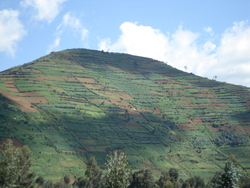
Rwanda’s investment in the CIP, now in its seventh season,(6) is major – $22.8 million per year – and crop production is responding accordingly. From 2007 to 2009, aided by abundant rainfall, maize and wheat harvests reportedly increased by 227% and 173%, respectively, and manioc underwent similar growth.(7) Average maize yields increased from 1.5 to over 4 tons per hectare for open-pollinated varieties and from 6 to 7 tons per hectare for hybrid varieties imported from Kenya and Tanzania. Overall, the nation’s agricultural production increased by about 14% per annum since the inception of the CIP, with grain imports decreasing by 20% per annum.(8) Spectacular short-term results, to be sure, and they derive in part from the methods employed. Still, they have more to do with the deployment of massive spending and political will, which have been lacking until now. And they come at a high cost for the Rwandan people and for peasant farmers in particular.
Figure 1: Food crop production in Rwanda
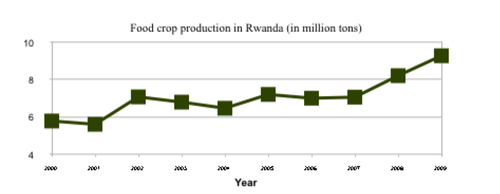
Source: MINAGRI, agricultural statistics for 2000–2009, available at http://www.minagri.gov.rw
An authoritarian intensification program
First of all, the CIP is not a consensus-driven process; there is no attempt to consider the needs and opinions of the main people affected. After succeeding in rebuilding and stabilizing a country ravaged by war and genocide in 1994, the 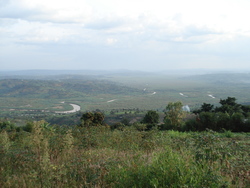
At the lowest level, independent small farmers have been forced into cooperatives as a means of ensuring that their farming activities comply with the program. In Cyuve, Musanze district, local officials ordered all crops other than maize to be pulled up after the region was assigned to grow maize at the start of 2009.(9)
A leader of the I.A.B.M. cooperative in Gitarama told how thousands of co-op members were forced to switch to growing maize and soybean seed: “The authorities wanted us to become commercial seed growers, but the women of the cooperatives wanted to keep growing sweet potatoes, cabbage, and other vegetables in the marshes. They wouldn’t back down and the authorities wound up sending in the army to pull up our crops.”
Strategic crops are identified for each administrative district: maize, rice, and manioc in the Southeast; potatoes, wheat, and maize in the north; flowers in Kigali province, and so forth. CIP participants, volunteer or conscripted, must comply with the Ministry of Agriculture’s program. They are told which crops to plant, forbidden from intercropping, and forced to practice monoculture in sync with their neighbours.
Compulsory monoculture
Intercropping in small-farm settings has been repeatedly shown to have multiple beneficial effects: atmospheric nitrogen fixation (if legumes are included), lower pest pressure, reduced erosion, efficient use of space, etc. But when peasants have to pay a high cost for commercial seeds, fertilizers, and pesticides, they are driven away from intercropping and towards monoculture, since it is easier for them to turn a profit by marketing larger quantities of a single product. In 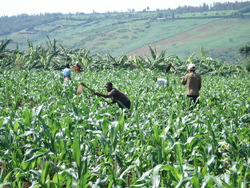
Disobedient farmers may also be fined. The president of a cooperative in Kayonza district told us that in order to keep his job he had to convince his members to stop intercropping beans and maize. However, many farmers need not be coerced into conformity: they have pledged their land as loan security, as the law now allows, and this makes them highly risk-averse. They plant exactly what the government tells them so that there is little chance of defaulting on the loan.
According to a 2009 study by Binart on the application of the CIP in Bugesera district, certain farmers involved in the program “expressed doubts about changes presented to them as compulsory. They say that they are afraid to challenge the district’s decisions. They simply apply the recommendations even if these go against the farmer’s beliefs. Certain farmers explained further that monoculture is not suited to the conditions under which many of them work, since they only have small acreages and prefer to plant a variety of crops so as to minimize risk.”(11)
The farmers interviewed stated that the main technical contributions made by the CIP were, in order of importance, monoculture, row cropping with prescribed spacing, use of commercial seed, pest control methods, and application of mineral fertilizers.(12) It is the same old recipe from the Asian “green revolution” and once again, farmers’ knowledge of plant breeding, crop associations, and crop rotation is being ignored.
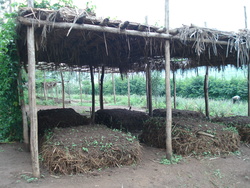
Table 1: CIP results, season A
| CIP deliverables | 2008A | 2009A | 2010A |
| Land consolidation (ha) | 28000 | 66000 | 254448 |
| Improved seed distribution (tn) | 600 | 1200 | 3000 |
| Chemical fertilizer imports (tn) | 6000 | 14427 | 33500 |
| Number of households reached by the CIP | 85000 | 200000 | 750000 |
Source: Crop Intensification Program, 2008-2009, Evaluation Report, IFDC, March 2010, p. 6
Erosion of agricultural biodiversity
Crop and varietal diversification are known to be important in pest and disease control. Furthermore, the continued existence of agricultural diversity provides farmers with the crop germplasm necessary to breed plants for changing environmental conditions. In contrast, the CIP replaces native crop diversity with one or two “improved” varieties per species over large areas (up to several hundred hectares), posing an unprecedented risk of disaster in the event of crop failure due to weather or pests.
Another major criticism of Rwanda’s regionalization or consolidation policy is that it is eliminating other crops crucial to food security and nutrition. Although much of the new maize production is taking place in previously uncultivated marshland, it is still “replacing previous crops (sweet potato, sorghum, taro, etc.) under orders from local program officials. This is causing the disappearance of traditional crops deemed insufficiently productive, replaced for the most part by non-native species considered more economically viable.”(15) Binart ranked different crops in terms of the share of the land area of CIP-participating cooperatives that they occupy and concluded that agricultural diversity has plummeted while, conversely, the proportion of the land occupied by maize has gone from 48% to 89%.(16)
Towards an inegalitarian agricultural model
The impact of crop regionalization and the concomitant loss of agricultural diversity can also be felt in the farmers’ markets. Little local produce is available, while staple items are now being shipped around the country. The nutritional quality of most vegetables and tubers is declining, post-harvest losses are greater, and food prices are on the rise. The price of staple foods on the local markets increased by 24% from 2006 to 2008. For beans and maize, the increases for the three years from 2006 to 2009 were 27% and 34% respectively (17), while the overall rate of inflation was only 9.8%.(18) The government wants to concentrate production in strategic areas and to require CIP participants to sell their harvests through prescribed official channels. While waiting for that to happen, peasants in northern Rwanda have nothing but maize to eat and no money to buy other food, while farmers markets remain shockingly bare.(19)
Like the Asian “Green Revolution” of the 1960s, the CIP is concentrating on a minority of better-off peasants, most of whom are organized into cooperatives farming the flatlands and marshes. Other than some government support for terracing and erosion control, there is little help available for the great majority of hill-dwelling peasants, who are dealing with serious erosion, soil fertility, and land fragmentation problems. Meanwhile, 15% of the rural population is landless, and their number is increasing. While there is no denying the government’s unprecedented investment in the farming sector and the short-term yield increases it has produced, empirical experience gives cause to doubt the benefits of chemical agriculture as compared with other approaches over the long run. On the negative side, soil depletion, environmental contamination, and loss of biodiversity are known outcomes of chemical agriculture. More crucially, the switch to costly imported inputs represents a frontal attack on the food sovereignty built up by Rwandan peasants over centuries. It is engendering an enduring dependency on lending agencies and the multinational agrichemical industry. The long-term outcome is likely to be a two-tiered agrarian society in which small farmers are disadvantaged in terms of access to land and markets, and where even their ability to feed their families may be compromised.
Big winner: the agrichemical industry
The coercive implementation of Rwanda’s new agricultural policy confirms as well that despite their remonstrance against deviations from democracy in countries of the Global South, international donors are perfectly willing to work with authoritarian states in applying neoliberal recipes and bolstering lucrative markets, such as the market in agricultural chemicals. Through the Global Food Crisis Response Program, the World Bank set aside $10 million in 2008 for purchase of mineral fertilizers in Rwanda.(20) Since the bulk of this fertilizer is purchased from multinationals, most of the money immediately reenters the economy of the industrialized countries. In Rwanda’s case, the Swedish company Yara International ASA is the main CIP beneficiary.(21) It is the world’s largest supplier of mineral fertilizers as well as the chief corporate sponsor of the African Green Revolution Forum (AGRF) held in Ghana from 2 to 4 September 2010 under the chairmanship of Kofi Annan. Yara pockets millions of dollars every year from the funds allocated. It also has fertilizer interests in most of the African countries adopting policies similar to Rwanda’s – Ghana, Malawi, Mozambique, and Tanzania, for example.(22)
In total, 80% of the CIP budget is earmarked for fertilizer purchases from multinationals.(23) While it may be dressed up in the humanist language of poverty reduction, this whole program – indeed, the whole of the so-called “Green Revolution for Africa” – hews closely to the neoliberal dogma shared by most international donors and is beholden to the interests of agribusiness.
Figure 2: Chemical fertilizers imported into Rwanda (in tons)
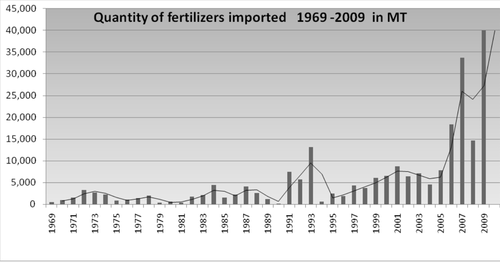
Source: Crop Intensification Program, 2008-2009, Evaluation Report, IFDC, March 2010, p. 8
The real green revolution
By investing massively in agriculture along with other sectors of the economy, the Rwandan government is demonstrating its firm commitment to getting the country on the track to sustainable development. It has just terminated the country’s status as an international food aid recipient and is now striving to capitalize on available aid money and donor confidence to bolster its food self-sufficiency and decrease imports. A salutary aim, if a necessary one given Rwanda’s lack of other options as a landlocked, resource-poor country. But while the country may in fact need a renewed agricultural strategy if it is to feed a population of ten million on an area of land smaller than Belgium, it is highly doubtful that the CIP will provide a sustainable response to the needs of the majority of Rwandan peasants.
In the most recent version of its strategy for agricultural transformation (PSTA II, 2009), the government seems to recognize the program’s limitations. Notably, it encourages the increased use of organic fertilizers, particularly manure from cow barns. It acknowledges that “to compensate for declining soil fertility, a solution may be to apply more inorganic fertiliser, but that costs money, which again requires foreign exchange and sets up a spiral of needing to apply increased amounts of fertiliser to compensate for worsening soil fertility. Moreover, fertiliser run-off has environmental impacts.… In contrast, sustainable agricultural practices reduce soil erosion and soil fertility decline, which mean that agricultural productivity is maintained at less cost.”(24) But these laudable aims will remain moot if the government does not take measures similar in scope to those included in the CIP. In the meantime, the quantity of chemical fertilizer imported has quintupled since 2005, while the area covered by the CIP quadrupled in 2010 and now accounts for 17% of the country’s total cropland.(25)
Yet other solutions exist. Scientific studies and practical experience show that the most sustainable and economical path involves taking advantage of peasant knowledge and making best use of techniques for restoring and maintaining soil fertility through nutrient cycling. Methods such as agroforestry, growing nitrogen-fixing legumes, intercropping, companion cropping, crop rotation, natural insecticides, and composting have proven their worth. Peasants can use them to improve soil fertility and yields. The Gako Organic Farming Training Centre in Kabuga, Rwanda offers yet another demonstration of the potential offered by sustainable techniques for soil fertility management.
Richard Munyerango, who trained in agroecology in Uganda, founded the centre in 2000 just a few kilometres from Kigali. “With organic agriculture we can produce sufficient quantities of healthy, varied foods while protecting soils and increasing their organic matter content year after year. We don’t depend on imported chemical fertilizers, which are expensive and damage our soils. All the fertilizers we use are free since they are made from livestock and harvest waste. Using techniques like composting and companion cropping, and with a few small animals for manure, even very poor families can increase their food security sustainably and regain their dignity as peasants.” The centre’s successes in recent years have attracted NGO support for delivery of organic agriculture training programs to thousands of Rwandan peasants. The sustainable, affordable, peasant-centered methods it advocates represent a viable alternative to the chemical agriculture model and deserve greater recognition and support from the authorities.
Instead of blindly forcing a minority of Rwandan farmers onto the costly chemical agriculture bandwagon, the government should be investing in agricultural progress that benefits the farming majority in Rwanda. Here as elsewhere, it is the small-scale farmers and peasants who are best positioned to sustainably assure the nation’s food security. To assist them, the country’s agricultural policy needs to capitalize on their real-world experience and knowledge. It needs to focus on restoring and improving soils, providing access to land, promoting participatory breeding of public-domain varieties, and safeguarding biodiversity. It will have to emphasize research and development of appropriate techniques that peasants can use to provide for their long-term food security and quality of life. And for all of this to happen, a thought revolution, an overturning of economic dogmas, will be necessary. Now more than ever, people’s food sovereignty is the order of the day.
-----
1 Norman Borlaug, father of the “Green Revolution,” famously characterized hybrid or high-yielding seeds as the “catalysts” that ignited the revolution and mineral fertilizer as the “fuel” that powered it.
2 “A New Green Revolution for Africa?”, GRAIN, December 2007, http://www.grain.org/briefings/?id=205
3 Agreement between the state, the regional economic organization concerned, the private sector, civil society, and the development partners.
4 The IMF and the World Bank require poor countries to produce a Poverty Reduction Strategy Paper (PRSP) as a criterion for access to international financing.
5 Strategic Plan for the Transformation of Agriculture in Rwanda – Phase II (PSTA II), February 2009, http://www.primature.gov.rw/index2.php?option=com_docman&task=doc_view&gid=903&Itemid=95
6 Rwanda enjoys two growing seasons: season A from September to January and season B from February to June.
7 Crop Intensification Program (2008–2009), Evaluation Report, IFDC, March 2010, p. vi, http://www. minagri.gov.rw/sites/default/files/user/CIP_2008-2009_Evaluation_report.doc.pdf
8 http://www.fao.org/giews/countrybrief
9 Albert-Baudoin Twizeyimana, “Rwanda: les agriculteurs produisent plus mais mangent plus mal,” April 2010, http://www.syfia-grands-lacs.info/index.php5?view=articles&action=voir&idArticle=1737
10 Loi organique n°08/2005 portant sur le régime foncier au Rwanda, J.O. no. 18 of 15/09/2005.
11 D. Binart, Le programme d’intensification des cultures de maïs au Rwanda face au développement durable: enjeux, pratiques et perspectives. Le cas du district de Bugesera, University of Maine, 2009, p. 54.
12 Binart, p. 51.
13 Unlike open-pollinated varieties, hybrid varieties do not breed true; that is, their progeny seeds generally do not produce the same characteristics as the parents. This means farmers cannot save and replant seed but have to purchase it again every year.
14 Binart, p. 66.
15 Binart, p. 48.
16 Binart, p. 47. Absolute figures not provided; the percentage estimate is derived from a survey of the cultivated area under different crops in 14 cooperatives totaling 10,000 members and working over 3000 hectares.
17 http://www.amis.minagri.gov.rw
18 http://www.indexmundi.com/rwanda/inflation_rate_%28consumer_prices%29.html
19 Twizeyimana, op. cit.
20 http://www.worldbank.org/foodcrisis/pdf/GFRPProjectStatus.pdf et http://web.worldbank.org
21 Crop Intensification Program, 2008-2009, Evaluation Report, IFDC, March 2010, p. 14.
22 http://www.yara.com et http://agrforum.com/sites/agrforum.com/files/AGRF_FdeD4.pdf
23 Crop Intensification Program, 2008-2009, Evaluation Report, IFDC, March 2010, p. 14.
24 PSTA II, p. 20.
25 Crop Intensification Program, 2008–2009, Evaluation Report, IFDC, March 2010, p. 14.
